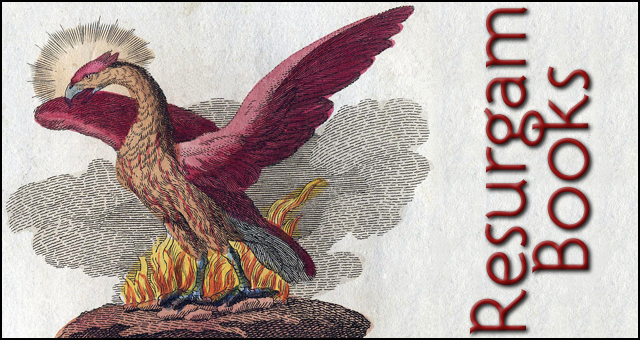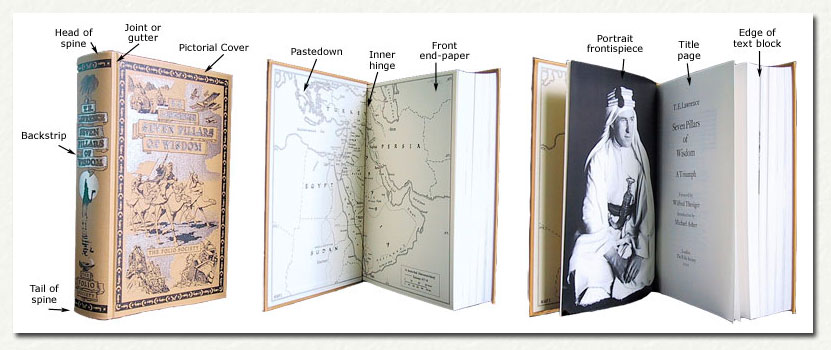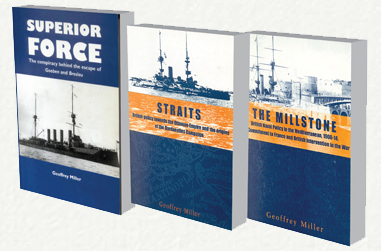 |
|
Guildford in the Great War
The Record of a Surrey Town
by
William H. Oakley
(Late Editor of the “Surrey Advertiser”)
|
|
 |
|
This is
the scarce 1934 First Edition |
 |
|


Front cover and spine
Further images of this book are
shown below
|
|
 |
|
 |
 |
|
|
|
Publisher and place of
publication |
|
Dimensions in inches (to
the nearest quarter-inch) |
|
Guildford: Billing & Sons, Limited |
|
5½ inches wide x 8¾ inches tall |
| |
|
|
|
Edition |
|
Length |
|
1934 First Edition |
|
232 pages |
| |
|
|
|
Condition of covers |
|
Internal condition |
|
Original green cloth blocked in black. The
covers are rubbed and there are some scuff marks on the rear cover near the
top corner. There are also a few minor marks and some variation in colour.
The spine has faded significantly with marked loss of original colour. The
spine ends and corners are bumped. There is a forward spine lean and some
indentations along the edges of the boards. |
|
There are no internal markings and the text is
clean throughout; however, the paper has tanned noticeably with age and the
illustrations have acquired a yellowish tinge. There is some separation
between the inner gatherings. The edge of the text block is grubby,
dust-stained and lightly foxed. |
| |
|
|
|
Dust-jacket present? |
|
Other
comments |
|
No |
|
This scarce 1934 First Edition remains in good
condition overall, with the two main points to note being the faded spine
and noticeable browning of the paper. |
| |
|
|
|
Illustrations,
maps, etc |
|
Contents |
|
Please see below for details |
|
Please see below for details |
| |
|
|
|
Post & shipping
information |
|
Payment options |
|
The packed weight is approximately
750 grams.
Full shipping/postage information is
provided in a panel
at the end of this listing.
 |
|
Payment options
:
-
UK buyers: cheque (in
GBP), debit card, credit card (Visa, MasterCard but
not Amex), PayPal
-
International buyers: credit card
(Visa, MasterCard but not Amex), PayPal
Full payment information is provided in a
panel at the end of this listing. |
|
|
 |
|
  |
|
 |
 |
|
Guildford in the Great War
Contents
Foreword
How the Great War Came to Guildford
First Days of War
"Your King and Country Need You"
Food Control
Care of the Sick and Wounded
Comforts, Billeting and Hospitality Financing
the War
Care of Belgian Refugees
The Menace from the Air
The Volunteer Training Corps and Special
Constables
Miscellaneous
Armistice and Peace Celebrations
Welcome Home
"Their Name Liveth"
The Roll of Honour
LIST OF
ILLUSTRATIONS
Mr. G. S. Odling-Smee, Mayor of Guildford,
1913-16
Mr. W. Shawcross, Mayor of Guildford, 1916-18
Mr. W. S. Tavener, Mayor of Guildford, 1918-20
Mr. A. D. Jenkins, Town Clerk of Guildford
Lady Rowley, Vice-President Guildford Division
Red Cross Society
Removing Wounded at Red Cross Annexe
Planting Peace Tree in Castle Grounds
The War Memorial
|
|
 |
 |
|
Guildford in the Great War
Excerpt:
THE MENACE FROM THE AIR
When the Zeppelin came to Guildford
One of what may be called the minor inconveniences of the Great War
was that our towns and cities were for a long time plunged into
almost inky blackness. But this minor inconvenience had to be
suffered in order to avert as far as possible the major one of being
bombed from the air by hostile aircraft. Although the possibility of
air raids was present to the minds of the authorities, it does not
appear to have been regarded seriously for the first two or three
months of the war, probably for good reasons.
But in October, 1914, it was deemed wise to take certain
precautions, and the Home Office issued a general Order, applicable
to the whole country, that where necessary " steps may be taken to
prevent the use of powerful elevated lights or sky signs which are
visible from a considerable distance," and in certain circumstances
might "serve as a guide to hostile aircraft." This was interpreted
by some in Guildford to mean that all outside lights of every kind
must be extinguished after sunset, but it was pointed out that this
was not the case, and that street lamps could not be regarded as
coming within the description of " powerful elevated lights." So
they continued to be lighted, though not for very long. In January,
1915, orders were issued that all lights " other than those not
visible from outside " were to be extinguished between the hours of
5 p.m. and 7.30 a.m., and that no headlights on motor cars should be
used, but sidelights only.
At once there was a remarkable transformation, and the clock seemed
to have been put back 100 years to a time when public lighting was
unknown. No one would have believed the difference the Order made
unless he had experienced it. The streets, save during the period
when there was a moon, were pitch black, for the Order applied to
all premises—private residences and business houses—and, where there
were lights inside, the windows had to be effectually screened so
that no glimmer could be discerned outside. Those who would have
been ready to declare that they could find their way about the town
blindfolded found that with their two eyes straining into the
darkness they could not be sure where they were going.
There were many amusing and some disconcerting incidents. People
bumped into one another on the pavement and in the roads, and begged
the pardon of those they could not see; the newsboys called the
evening papers, and had their contents bills, but neither boys nor
bills could be seen. One had to be careful walking on the path lest
one slipped off the kerb; and it was a weird experience late at
night for two people to be walking towards one another in the road,
and each to hear the other hesitate and falter as they got near
because neither knew exactly where the other was.
Some bumped into the lamp posts; one at least found himself hurled
back on to the road when his head came in contact with a tree he was
unable to see, and he had a beautiful black eye for a week
afterwards. It was possible sometimes to keep direction by watching
where the houses on either side were visible against the sky, but
this help was not available on moonless or very dark nights.
Altogether a walk abroad at night was something of an adventure, and
many made it a rule not to stir from their houses after dark unless
they were compelled to do so. Some who did carried electric torches,
which could be seen flashing occasionally—though the constant use of
such aids was officially frowned upon; and a few carried
old-fashioned lanterns with candles which gave a faint but
sufficient illumination.
This Order—issued about the middle of January, 1915—was revoked in
part in a day or two, but after the first air raid in this country
the regulations were gradually tightened up and, later on, rigidly
enforced. Householders throughout the borough had to screen their
windows so that no light could filter through. Some put dark paper
over the inside of existing blinds; many had to go to the expense of
special blinds. Shopkeepers were subject to the same necessity, and,
in particular, skylights had to be effectually covered up. The
churches and chapels were not exempt. They, too, had to cover their
windows so that no light was visible outside, and, as may be
imagined, in certain cases this was difficult, and meant a good deal
of expense. In some churches the hours of service were altered, and
evensong on Sundays and other days was held in the afternoon so that
people would have time to get home before darkness fell.
For a while some of the street lamps were lighted, but the upper
part of the glass was blackened so that the light would only shine
downwards. To mitigate to some extent the inconvenience and the
danger of the darkened streets the kerbs at corners were
whitewashed, and some of the trees by the roadside were whitened to
a height of five feet to make them more easily visible. At a later
stage even perambulators had to have a white light at the side and a
red light at the rear. The blinds of trains had also to be drawn at
night. The effect upon trade was for a time serious, but gradually
residents got into the habit of doing their shopping by daylight,
and the traders began to close early.
In November, 1915, the Guildford Chamber of Trade appealed for a
relaxation of the lighting restrictions in their town, as they
considered it outside the air raid danger zone; but, unfortunately
for them, a Zeppelin had reached Guildford a month earlier, and the
Home Secretary declined to accede to the request. In their annual
report two or three months later the Committee of the Chamber of
Trade stated that "the stringency of the lighting regulations has
turned shopping after dark into something of an adventure not
lightly to be undertaken, and the deadly dullness of trade has
caused most of the traders who could possibly do so to put up their
shutters at the early hour suggested by the Chamber." Another
regulation which arose out of the menace from the air was that
clocks were not to strike the hours or quarters, and the church
bells were forbidden to be chimed or rung after dark, lest the
sounds should serve as a guide to aircraft hovering overhead.
Air Raid Precautions.—In May, 1915, a notice was issued by the Mayor
(Mr. G. S. Odling Smee) advising the inhabitants what to do and what
not to do in the event of an air raid. They were advised to get
under shelter at once if in the streets; school teachers were
recommended to continue lessons, but in the event of damage to
buildings to march the children out as at fire drill; those in
Government and municipal offices were advised to continue at work;
those in private houses were recommended to stay there and not to "
rush out to see what is going on."
At one time it was suggested that the siren at the Electricity Works
should be sounded when enemy aircraft were reported to be on the
way, but a very short experience of this method was enough. The long
unearthly wail that went forth was blood-curdling, and some declared
they would rather risk a raid than undergo such torture. Besides, it
was pointed out, such a penetrating shriek would be heard a long
distance away, and would guide airships to the spot. So this was
soon stopped.
At a later period of the war the Guildford Education Committee
issued a notice to head teachers of all the elementary schools in
the town that in the event of notice being received of an impending
air raid during school hours the children were to be dismissed at
once and told to go home as quickly as possible. This did not find
favour with some people, and it was contended that it would be
better to keep the little ones in school rather than send them out
panic-stricken into the streets.
The special constables who were enrolled shortly after the outbreak
of war had instructions what to do in case of air raids, and the St.
John Ambulance Brigade, as is recorded in another section of this
record, were also on duty on these occasions, and they fitted up a
temporary receiving ward for 20 patients in the Congregational Hall
to deal with any casualties that might arise. The Guildford Division
of the British Red Cross Society also offered their assistance to
the authorities in attending to any who might be injured in air
raids on the town, and Lady Rowley, vice-president, made an appeal
for recruits for this service.
The Coming of the Zeppelin
According to Captain Joseph Morris, author of " The German Air Raids
on Great Britain," there were in the course of the war 51 airship
attacks and 52 aeroplane attacks on this country. In these raids
9,000 bombs, of an estimated total weight of 280 tons, were dropped.
Great damage was done to property in London and elsewhere, and 1,413
persons were killed and 3,408 injured. London suffered more than
half these casualties, 670 persons being killed and 1,962 injured in
the Metropolis.
The raid on Guildford took place on the night of Wednesday, October
13, 1915, and it was a beautifully clear night. Five airships
crossed the North Sea to our coasts, and they dropped in all 102
explosive bombs and 87 incendiary bombs, killing 71 people and
injuring 128. London's share of these casualties was 38 killed and
87 injured.
The Zeppelin that reached Guildford was the L. 13, and it was in
command of Kapitanleutnant Mathy, one of the most daring and capable
commanders in the German Naval Air Service. He and the commander of
another Zeppelin were to circle London and attack it from the
south-west and southeast respectively. In his book quoted above,
Captain Morris says that "Mathy, in the L. 13, swept round by St.
Albans, Watford, Uxbridge and Staines, and so to Guildford, where he
twisted about, momentarily lost. Then he resumed his outward circle,
passed Redhill, then on to Bromley, and next Woolwich, which he
reached shortly before midnight." He was attacked by gunfire near
Hatfield on his return journey to the coast, but got away—this
time—without mishap.
There are several different versions of the attack on Guildford, and
many speculations and conjectures have been made as to the objective
or objectives of the commander of the Zeppelin. Something may be
said on these points hereafter, but we will now proceed to give the
official report of the Press Bureau, issued on the morrow of the
raid; an impression jotted down hurriedly an hour or two after the
attack; and the detailed official account released by the Press
Bureau after the conclusion of the war.
But we must preface the official report issued on October 14, 1915,
by a few words of explanation. At this time the strictest Press
censorship was in force. Not only was every newspaper editor
forbidden, on pain of heavy fine or imprisonment or both, to publish
any details of such raids without previous submission to the Press
Bureau, but he was also forbidden to indicate in any way the
localities affected by the raids. The restrictions went even
further. There was a general prohibition even against the
compilation of accounts of such raids and of other information which
might by any possible chance get into the hands, or to the
knowledge, of the enemy.
So it will be seen that it was quite out of the question for local
papers to do what in ordinary circumstances would have been
done—-give a detailed description of the raid, with particulars of
where bombs were dropped, the damage done, and interviews with those
who had any first-hand knowledge. Indeed, so drastic were the
restrictions and prohibitions, so serious the consequence of any
infraction, that two local papers did not feel justified in
publishing a single word of the Guildford raid in their columns lest
it might be held that such publication indicated the locality in
which bombs were dropped.
As it happened, the Editor of the " Surrey Advertiser " had a short
time before submitted in duplicate to the Press Bureau a certain
report he desired permission to publish, and had received, with the
permission, an intimation that the Press Censors should not be
troubled unduly, but that editors should exercise their own
discretion. So in this particular matter the
Editor did exercise his discretion by reproducing the official
report, though for a few days afterwards he had visions of a
court-martial and subsequent solitary confinement in the Tower or
elsewhere for a few months.
But to get on. Here is the official report, issued by the Press
Bureau on Thursday, October 14, the day after the raid:
" The War Office announces that a fleet of hostile airships visited
the Eastern Counties and a portion of the London area last night,
and dropped bombs. Anti-aircraft guns of the Royal Field Artillery,
attached to the Central Force, were in action.
" An airship was seen to heel over on its side and to drop to a low
altitude. Five aeroplanes of the Royal Flying Corps went up, but,
owing to atmospheric conditions, only one of the aeroplanes
succeeded in locating an airship.
" This aeroplane, however, was unable to overhaul the airship before
it was lost in the fog.
" Some houses were damaged, and several fires started, but no
serious damage was caused to military material. All the fires were
soon got under by the Fire Brigade. The following military
casualties, in addition to the one announced last night, have been
reported: Killed 14; wounded 14 . . .
|
|
 |
|
  |
 |
|

Please note: to avoid opening the book out, with the
risk of damaging the spine, some of the pages were slightly raised on the
inner edge when being scanned, which has resulted in some blurring to the
text and a
shadow on the inside edge of the final images. Colour reproduction is shown
as accurately as possible but please be aware that some colours
are difficult to scan and may result in a slight variation from
the colour shown below to the actual colour.
In line with eBay guidelines on picture sizes, some of the illustrations may
be shown enlarged for greater detail and clarity.















 |
|
 |
|
 

|
 |
|
U.K. buyers:
|
To estimate the
“packed
weight” each book is first weighed and then
an additional amount of 150 grams is added to allow for the packaging
material (all
books are securely wrapped and posted in a cardboard book-mailer).
The weight of the book and packaging is then rounded up to the
nearest hundred grams to arrive at the postage figure. I make no charge for packaging materials and
do not seek to profit
from postage and packaging. Postage can be combined for multiple purchases. |
Packed weight of this item : approximately 750 grams
|
Postage and payment options to U.K. addresses: |
-
Details of the various postage options can be obtained by selecting
the “Postage and payments” option at the head of this
listing (above).
-
Payment can be made by: debit card, credit
card (Visa or MasterCard, but not Amex), cheque (payable to
"G Miller", please), or PayPal.
-
Please contact me with name,
address and payment details within seven days of the end of the
listing;
otherwise I reserve the right to cancel the sale and re-list the item.
-
Finally, this should be an
enjoyable experience for both the buyer and seller and I hope
you will find me very easy to deal with. If you have a question
or query about any aspect (postage, payment, delivery options
and so on), please do not hesitate to contact me.
|
|
 |
 |
|
International
buyers:
|
To estimate the
“packed
weight” each book is first weighed and then
an additional amount of 150 grams is added to allow for the packaging
material (all
books are securely wrapped and posted in a cardboard book-mailer).
The weight of the book and packaging is then rounded up to the
nearest hundred grams to arrive at the shipping figure.
I make no charge for packaging materials and do not
seek to profit
from shipping and handling.
Shipping can
usually be combined for multiple purchases
(to a
maximum
of 5 kilograms in any one parcel with the exception of Canada, where
the limit is 2 kilograms). |
Packed weight of this item : approximately 750 grams
| International Shipping options: |
Details of the postage options
to various countries (via Air Mail) can be obtained by selecting
the “Postage and payments” option at the head of this listing
(above) and then selecting your country of residence from the drop-down
list. For destinations not shown or other requirements, please contact me before buying.
Due to the
extreme length of time now taken for deliveries, surface mail is no longer
a viable option and I am unable to offer it even in the case of heavy items.
I am afraid that I cannot make any exceptions to this rule.
|
Payment options for international buyers: |
-
Payment can be made by: credit card (Visa
or MasterCard, but not Amex) or PayPal. I can also accept a cheque in GBP [British
Pounds Sterling] but only if drawn on a major British bank.
-
Regretfully, due to extremely
high conversion charges, I CANNOT accept foreign currency : all payments
must be made in GBP [British Pounds Sterling]. This can be accomplished easily
using a credit card, which I am able to accept as I have a separate,
well-established business, or PayPal.
-
Please contact me with your name and address and payment details within
seven days of the end of the listing; otherwise I reserve the right to
cancel the sale and re-list the item.
-
Finally, this should be an enjoyable experience for
both the buyer and seller and I hope you will find me very easy to deal
with. If you have a question or query about any aspect (shipping,
payment, delivery options and so on), please do not hesitate to contact
me.
Prospective international
buyers should ensure that they are able to provide credit card details or
pay by PayPal within 7 days from the end of the listing (or inform me that
they will be sending a cheque in GBP drawn on a major British bank). Thank you.
|
|
 |
 |
|

(please note that the
book shown is for illustrative purposes only and forms no part of this
listing)

Book dimensions are given in
inches, to the nearest quarter-inch, in the format width x height.
Please
note that, to differentiate them from soft-covers and paperbacks, modern
hardbacks are still invariably described as being ‘cloth’ when they are, in
fact, predominantly bound in paper-covered boards pressed to resemble cloth. |
|
 |
 |
|

Fine Books for Fine Minds |
I value your custom (and my
feedback rating) but I am also a bibliophile : I want books to arrive in the
same condition in which they were dispatched. For this reason, all books are
securely wrapped in tissue and a protective covering and are
then posted in a cardboard container. If any book is
significantly not as
described, I will offer a full refund. Unless the
size of the book precludes this, hardback books with a dust-jacket are
usually provided with a clear film protective cover, while
hardback books without a dust-jacket are usually provided with a rigid clear cover.
The Royal Mail, in my experience, offers an excellent service, but things
can occasionally go wrong.
However, I believe it is my responsibility to guarantee delivery.
If any book is lost or damaged in transit, I will offer a full refund.
Thank you for looking.
|
|
 |
 |
|
Please also
view my other listings for
a range of interesting books
and feel free to contact me if you require any additional information


Design and content © Geoffrey Miller |
|
 |
|
|
|